A respect for the doctrine of economy, so universally invoked as a touchstone of great art, often spurs the analyst's search for unity in those works which, perhaps for subjective reasons, have attracted his admiration. While other factors too may exert their influence in the shaping of a great work, it never really surprises us to discover unifying economies in the structure of a masterpiece that may, at first hearing, seem luxuriant or even freely discursive. Palestrina's Missa Papae Marcelli1 makes just such a first impression, yet surely it could not have maintained its lasting appeal if it did not make good musical sense to us. The special quality of its logic resides in the hitherto unspecified economy of its melodic language.
That a work of such enduring fame should still lack a persuasive explanation of its power to move successive generations of listeners implies no disparagement of the contributions of other analysts.2 Analysis is primarily a modern concern, one which would have seemed superfluous to the didactic theorists of the Renaissance. Tinctoris, Gafurio, Aron, Glareanus, Zarlino, Cerone, et al. devoted themselves to the training of composers and performers—not criticism. They directed even their most speculative essays, ultimately, toward the practical task of explaining how things ought to be done, not how or why they had been done. Only rarely and indirectly do they allow us a glimpse of the creative ingredients of their craft. Analysis was no part of their business, but it is ours.
Our analysis of Renaissance music measures our ability to demonstrate our understanding of it, yet that ability has scarcely left its infancy. Basic work remains undone in every branch of polyphony. The presence of a cantus prius factus provides useful clues to the nature of Renaissance variation technique.3 But have we begun systematically comparing large numbers of compositions using the same cantus firmus in order to discover what may have been conventional or original, necessary or permissible? Do the tools for such a study exist? A modest beginning has been offered for the study of paraphrase technique, but we have not even begun to unravel the history of paraphrase style.4 As yet we do not have a simple, generally applicable tool to describe parody, to compare a parody work with its model or with other parodies of the same model.5 Where a composer has given marked attention to the expression or depiction of a text, that text can often prove an invaluable guide to the music. But even here we cannot really claim to know the basic conventions of word painting or dramatic expression, for no repertory-wide surveys of the practice exist.6 Nevertheless, these open questions do not deter us from pronouncing on the beauty, excellence, and originality of this or that composition. Although happily we will probably never rid ourselves of that subjectivity, we do not sufficiently acknowledge the disproportionate role it plays in our judgments of Renaissance music, the relative ignorance in which we currently form our opinions.
Freely composed polyphony may sometimes offer fewer direct clues to its nature than any other branch of the art, but that does not mean that it necessarily lacks logic or order. The motivic practices cultivated by Josquin in paraphrase style were still available to him—indeed, most natural for him to adopt—when he worked without a cantus prius factus,7 and it seems natural to suspect the same for Palestrina. Not only does this prove to be the case, but Palestrina's melodic writing, at least in this Mass, seems even more prophetic than Josquin's of those developmental and transformational techniques familiar to us in the music of later eras.
As far as anyone knows, the Missa Papae Marcelli is freely composed. The opinion of Samson, Fellerer, and others, that the Mass takes the tune L'homme armé as it model,8 will not stand up to the close examination conducted here. The head-motif of the Mass does, of course, bear a resemblance to that tune, but so do numberless other passages in sixteenth-century music. For example, Arcadelt's celebrated Il bianco e dolce cigno ends on a point almost identical with Palestrina's. (Ex. 1)
Ex. 1
a) Arcadelt, Il bianco e dolce cigno, alto, measures 35f 9 and
b) MPM, Kyrie I, Tenor I, measures 1-4

Considering the popularity of that madrigal in Palestrina's time, and recognizing that the French tune survived merely as a professional exercise, it might seem far more reasonable to cite the madrigal as Palestrina's source. However, as pointed out by Gustave Reese (among others) the upward fourth followed by stepwise descent had become a commonplace of sixteenth-century style.10 We have no more reason to seek a source for this natural contrapuntal gesture than for the scale itself. Furthermore, since L'homme armé includes several other distinctive and rhythmic features which have no effect on the content of the Mass, we may safely reject the similarity as coincidental.
We may with almost equal assurance take the same view of the similarity cited by Jeppesen between the Christe of our Mass and Palestrina's Missa Benedicta es.11 While Jeppesen's comparison gains authority from the fact that the composer may have consciously or otherwise quoted from himself, the significance of the resemblance remains in doubt. We may never know whether Palestrina, working in haste, created a pastiche out of materials nearest at hand, but his reuse of them has no more meaning than Schubert's quotation from Der Wanderer in his Fantasy in C. The question turns on how the materials were used and not on their source. Jeppesen himself pointed toward such a conclusion when he listed ten other compositions in which Palestrina used versions of the Kyrie's head-motif,12 and when he cited four additional possible origins for the melodic substance of the Mass proposed by Felix Raugel.13
The number, divergence, and persistence of these attempts to identify some cantus prius factus for our Mass14 make it evident that we are dealing with a style embracing all the pitfalls of coincidental resemblance deplored by LaRue in another stylistic context.15 Given the homogeneous character of so much sixteenth-century music, the wonder is that we do not have more proposals of this kind. Of course we cannot dismiss them all out of hand; for example, when Raugel16 calls attention to the identity between the acclamations Laudamus te; Benedicimus te in the Gloria of Mass XV and Palestrina's setting of the same words,17 the resemblance seems too strong to ignore—in spite of the modal difference between the passages. Nevertheless, the fundamental similarity between Palestrina's melodic language and that of plainchant diminishes the probability that Palestrina deliberately quoted the Gloria as a model.18 In the absence of other evidence such resemblance need detain us no longer than the similarity between the opening measures of the "Prague" and "Jupiter" symphonies of Mozart.
Whatever risks surround the hunt for similarities between distinct compositions, we may not extend the same suspicions to similarities between movements of the same composition without further consideration. Although LaRue has shown how family resemblances may often simulate genuine unities, he does not ascribe all similarities to coincidence.19 If we grant the consistencies of sixteenth-century style in general, and the uniformity of Palestrina's style in particular, how can we, without confirming external evidence, reasonably attribute perceived resemblances to the compositional process, rather than to the workings of chance? This question does not stand alone. The Ordinary of the Mass is functional music which must tolerate lengthy "interruptions" by ritual and by other music in the course of its execution. Can distant thematic references have any meaning or effect in such a context? What kind of audience would have appreciated or even recognized them in the midst of other—presumably more important—business?
While we can do little more than speculate about the frequency of private or nonceremonial performances of sacred music, occasions at which composers might have sought the professional approval of their colleagues,20 the overwhelming evidence of the Mass repertory proves that composers customarily unified their Masses with reference to a cantus prius factus. Their recurrent references to it in the course of their setting must have contributed something to the unity of the ceremony as a whole. This explains why composers frequently had resort to immodest tunes repugnant to the architects of the Counter-Reformation. They had a basically serious intent; the better the congregation knew the tune, the more they would perceive the musical unity of the sacred ritual. But whatever the reason, thousands of surviving Masses and Mass movements testify that their composers sought unity in their settings of the Ordinary, not occasionally but habitually.
Against this background, the quest for unifying features in freely composed settings of the Ordinary appears not only natural, but advisable. If music normally contributed to the unity as well as to the aural beauty of the Mass, that mission did not lapse simply because a composer elected to compose freely in some rare instances. On the other hand, Jeppesen's examples (see note 12)—and it requires only patience to find more—warn us that we have no right to assume that the presence of melodic similarities constitutes prima facie evidence of their structural intent. The compactness of Palestrina's melodic diction denies us the liberty of inferring premeditated structural significance in such resemblances without the support of overwhelming musical evidence.
Before examining the evidence of unity in the Missa Papae Marcelli, we must first clarify some of the assumptions behind that examination. We may term the first of these a paraphrase corollary. Compositions based on paraphrase technique allow us to form some idea of how Renaissance composers dealt with a given melodic subject, and what potential for variation or elaboration they perceived in it. Yet paraphrase could have had little effect unless the cantus prius factus remained recognizable for at least some part of the process. Thus such compositions offer a relatively conservative view of the possibilities a composer might have deemed inherent in the given material. Be that as it may, the existence of paraphrase as a genre makes it evident that composers were familiar with such relationships and that they could avail themselves of them just as easily in free composition (see note 7). We know of no reason why they could not have used them at pleasure. Morley, writing about the instrumental fantasy (a freely composed genre that has obvious affinities with freely composed vocal polyphony), describes it as a style in which a composer "taketh a point at his pleasure and wresteth and turneth it as he list, making either much or little of it according as shall seem best in his own conceit. In this may more art be shown than in any other music because the composer is tied to nothing, but that he may add, diminish, and alter at his pleasure. And this kind will bear any allowances whatsoever tolerable in other music except changing the air."21 Although Morley makes no similar declaration in his discussions of vocal music,22 choosing to emphasize instead his obvious concern for sensitive text setting, that does not diminish the aptness of his remarks to the problem of free composition.
The point that a composer "wresteth" must sometimes alter its shape to fit the demands of the other voices.23 Because the original point and its derivative participate in the same discourse, that association implies a functional equivalence between them. As our ears tell us, the derivative can represent the original idea in an appropriate musical context. Thus we may assume that the different forms of the opening subject of the Missa Papae Marcelli, KI/1 (see key to the tables) are functionally equivalent in that opening point. Table 1 groups those forms according to their transpositions as dux, comes, and resultant (a term chosen arbitrarily to identify further transposition of the subject).24
Table 1
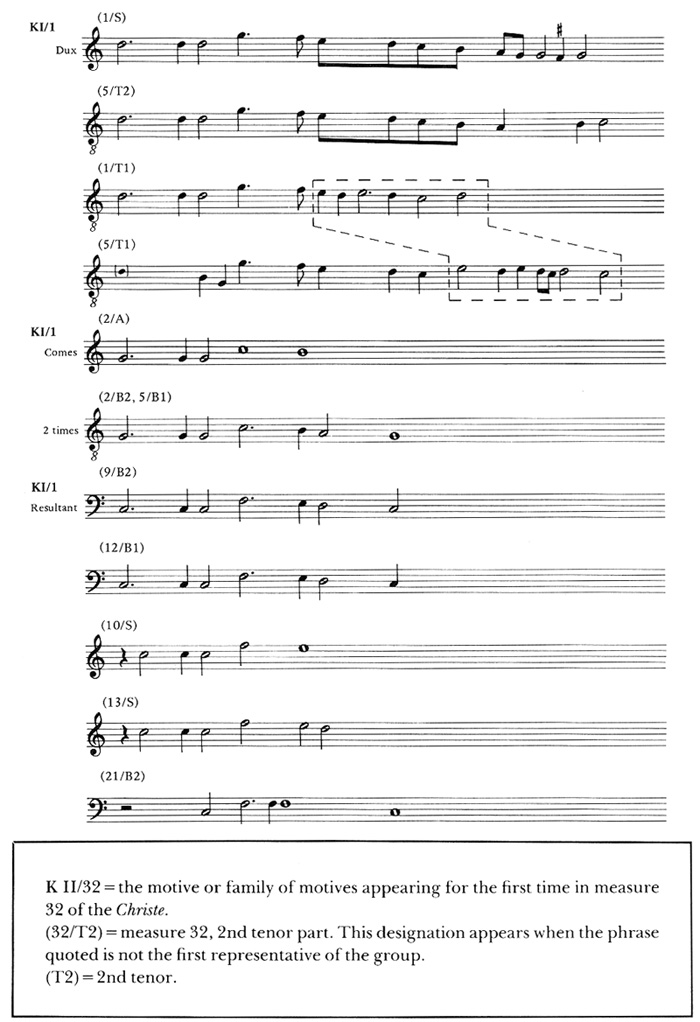
All but two of the forms begin with the same or similar rhythm. The last entry, 21/b2, appears only for the sake of completeness; it probably owes its shape to its cadential position rather than to thematic intent. Despite its differing text (eleison), its opening upward fourth may have the power to recall, in some small degree, the first leap of the subject. Of the twelve entries shown, only 5/t1 lacks the opening upward leap of a fourth, but it makes unmistakable reference to the opening subject.25
The concept of functional equivalence leads naturally to a notion that I have characterized elsewhere as a "pseudo-Euclidian" postulate.26 Without implying the rigor of Euclid's "Things equal to the same thing are equal to each other," we must recognize the musical logic that: Motives related to a common motive may be related to each other. Observe that words like "must" and "always" do not appear in that statement. It expresses a musical possibility—perhaps even a probability—but not a law. Its valid application rests, like all analysis, on musical common sense.27
Even without a formal descriptive table, the structural equivalence of the motivic family KI/1 impresses itself on every ear. It embodies the unity one expects to hear in a point of imitation. It maintains that unity throughout the first fifteen measures in spite of varying continuations and truncations as drastic as those at 2/a and 10/s. The variety of these motives seems quite conservative when compared with the closing point of the Christe, family KII/32 (Tables 2 and 3).
Table 2
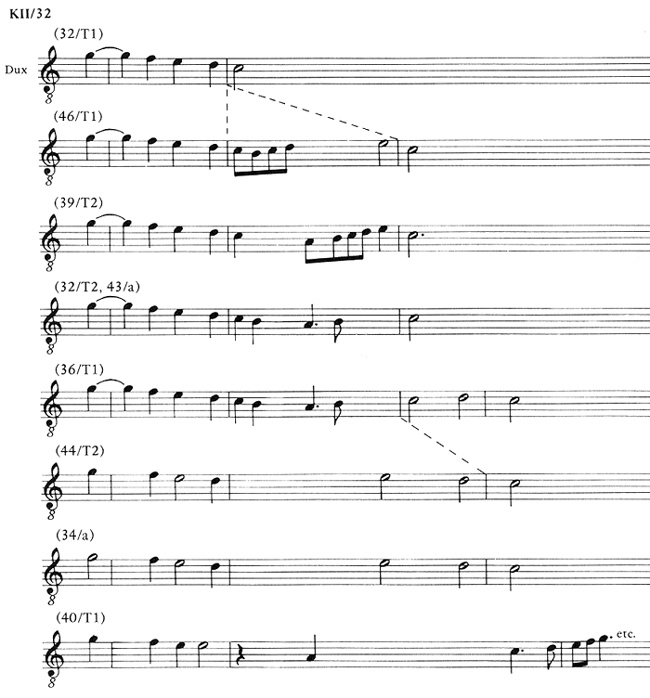
Table 3
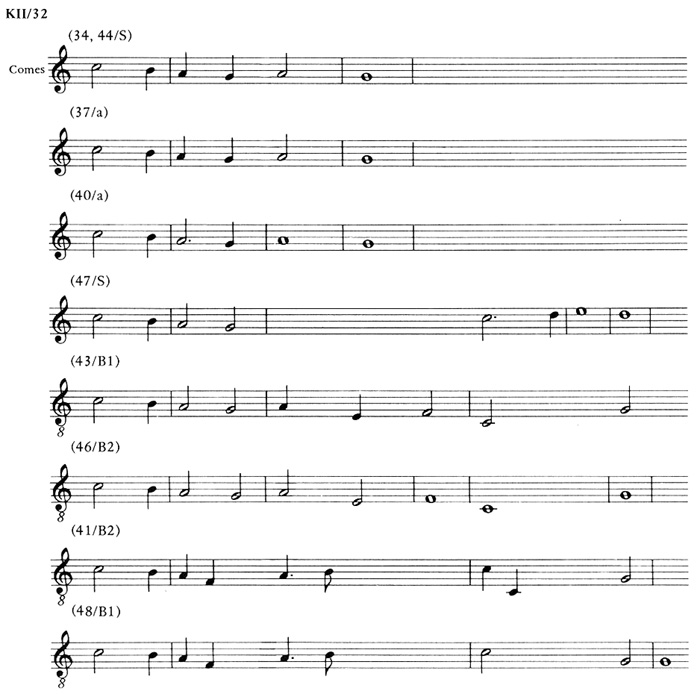
The subject there, a seemingly colorless fall from g to c (and c to g in comes), incorporates 11 different continuations and half-a-dozen variant beginnings into its domain, and raises a basic question about its thematic intent.
The prominent placement and significant imitation of KI/1 grant it an importance which, as a cliché of sixteenth-century style, it might not have attained in some other context. The same may be said of KII/32 and its consequents which form a rhythmic and imitative embellishment of a somewhat bare melodic cadence. But for all their commonplace character, the two families, KI/1 and KII/32, have that stepwise fall from g to c (and c to g) in common. Does the end of the Christe then, make thematic reference to the beginning of the Kyrie? Or does the ubiquity of the short descending scale fragment oblige us to ignore its strategic placement and to ascribe the similarity to coincidence.
A surprising weight of substantial evidence throughout the Mass seems to favor the view that, while the connection between these two families of motives may seem tenuous and perhaps less important than others, it is nonetheless intentional. As we shall see, movements and sections within movements are linked not only by overt thematic references, but even more pervasively by a subtle quality of musical rhyme. Melodic or rhythmic similarities at the beginnings or endings of phrase units recur so frequently in the course of the Mass, that while insignificant in themselves, they have the cumulative effect of inviting us to hear them as families of continuously varying yet related ideas. The motivic units discussed below have no especially distinctive character. They are not unique melodies like the highly individual themes we associate with this or that work by Schubert or Beethoven. Renaissance composers seem to have concerned themselves less with creating completely original melodies than with varied and original treatment of their materials—a natural posture for composers who often devoted their major efforts to parody and paraphrase.
Obviously the internal unity of a conventional point of imitation like KI/1 cannot serve as evidence of the kind of unity under discussion here, with all the hints of cyclical construction and thematic transformation that have strewn the reader's path thus far. However, we do not have to look very far for decisive evidence of premeditated thematic unity between movements and between distant sections of movements. The point of imitation that opens the Mass all but reappears as the opening of Agnus Dei I (the order of voices changes slightly—B2 replaces B1, and the alto delays for another pulse—but a glance at the score shows that the two points are for all practical purposes identical). Beyond any possible shadow of doubt, the subject of that point of imitation in the Agnus Dei (AI/1) belongs to the same family as that of the opening point of the Kyrie KI/1 (see Table 4 and compare lines 1 and 7).
Table 4
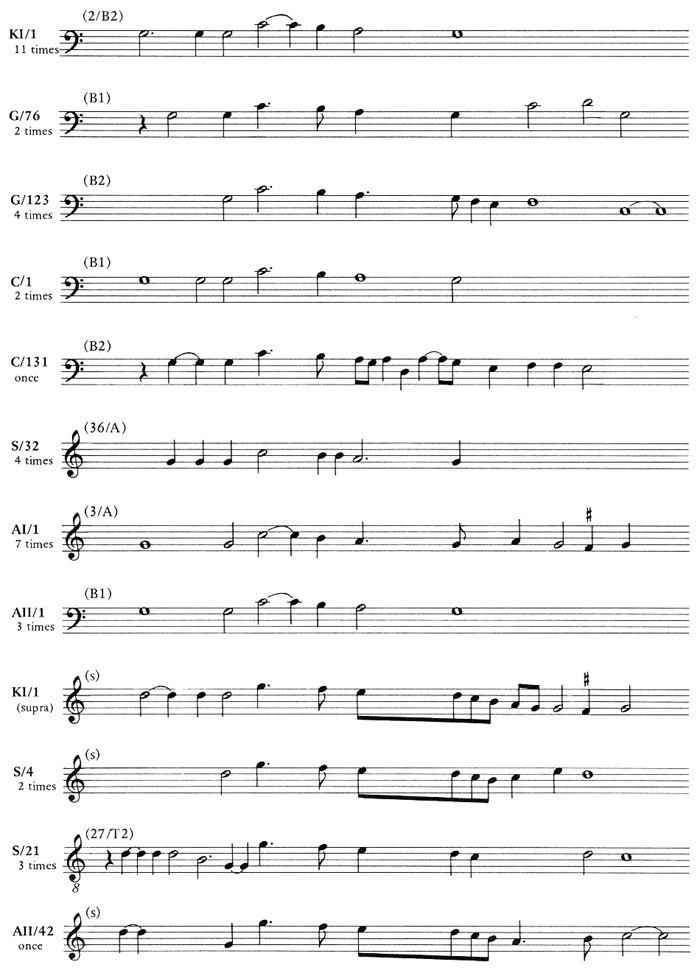
The connection of that family to the forementioned sixteenth-century cliché certainly does not weaken the resemblance, but rather heightens the recognizability of its return in the Agnus Dei. Commentators have not made much of this thematic reappearance for the very natural reason that we often hear such things in parody and paraphrase Masses, where we may easily explain them without anachronism as the composer's treatment of his cantus prius factus.28 We seem to have overlooked the fact that when they occur in a freely composed Mass, such returns have the same allusive power as those in the last movement of the Beethoven Ninth Symphony or Berlioz's Harold in Italy. The Agnus Dei itself seems to confirm the significance of the family resemblance. The subject, heard 11 times at the opening of the Kyrie, sounds seven times in the opening of the Agnus Dei, recurs half-a-dozen times as a transformed subject of imitation on the words miserere nobis (measures 34-49; not shown in Table 4), and then begins the three-voice canon that forms the structural framework of the second Agnus Dei (AII/1). Surely those 16 statements at the end of the Mass testify to more than a coincidental relationship with the subject of the opening (KI/1). How can we refuse to accept them as evidence of the composer's intent? Whatever our natural reluctance to read the composer's mind, do we have any more compelling evidence that allows us to report significant connections between the first and third movements of Beethoven's Fifth Symphony, or between the opening and closing measures of Brahms's Third Symphony?
Only our well-grounded fear of imposing twentieth-century attitudes on Renaissance composers has made us reticent to recognize such a familiar musical practice in their styles. But what argues against it here? If the Missa Papae Marcelli drew on some yet unknown cantus prius factus, that would provide a commonplace explanation for the unity created by the thematic return—an explanation that might color the character of that unity, perhaps, but could not deprive it of any significance. If, as most believe, the Mass is freely composed, we may take the passages under discussion as overtly and intentionally related.29
Further conclusions, which may at first seem even more anachronistic, seem to follow from the foregoing argument and the assumption made earlier. If all the members of a melodic family are functionally equivalent, and if they owe the variety of their shapes to the operations of paraphrase technique, we may extend the family to include motives of similar character in other parts of the composition. The Missa Papae Marcelli contains at least 50 members of the family KI/1 (Table 4 identifies 40 of the nearest relatives). If we discern an intentional thematic connection among the 27 statements of the idea in Kyrie and Agnus Dei, can we reject the balance of them as melodic accidents scattered through some ten locations in Gloria, Credo, and Sanctus? That interpretation would concede to coincidence a power that undermines the foundations of analysis. Having come this far, we must acknowledge that the extended family KI/1 runs through the Mass like a constantly varied idée fixe. Its progress seems to follow no system, and apart from lending something of a framing character to the outer movements, it does not seem to articulate the Mass into significant structural divisions. It recurs neither regularly nor prominently, yet its presence cannot help but endow any passage in which it appears with an appropriateness to the melodic language of the whole Mass. It makes no difference that the thematic substance of KI/1 is a common property of Renaissance style; so is the Pange lingua or any other cantus prius factus used as an organizing tool. That very currency serves only to augment the power of a melody to unify a varied and extended composition.30
Table 4 may draw the objection that it offers in evidence a jumble of lower and inner voices instead of relying on the highest voice. However, many factors contribute to thematic significance; it does not always sit complacently in the highest sounding part. From the basic presumption of equality among the voices, it follows that any voice may claim thematic interest at one time or another. Indeed, why leave it to boy sopranos when mature, responsible, and experienced lower voices may perhaps prove more effective? Passing over such obvious factors as contrasting tessitura, relative activity, syllabic density, type of motion, etc., we may point out that a melody heard earlier may, at its return, gain in thematic weight among the other parts because of its familiarity. Also more than one part at a time may compete for and even share priority. On the other hand, when two parts move in parallel thirds (or sixths, tenths, etc.) they merge into a unit in which either part may represent their combined identity—another type of functional equivalence. (The same holds true for parallel triads.) These, and in special cases other factors have influenced the analyses offered here. Whatever their imperfections, they have not been cut to fit preformed arguments; on the contrary the arguments have been deduced from the tables of observations.
Two questions arise at this point. How do other motivic procedures in the Mass compare with those observed in the KI/1 family? And does the Mass include other families of motives that contribute to its unity?
Palestrina sometimes treats a melodic subject as if it has a core in which its identity resides and survives no matter how the core is approached or left. For most of the members of the family KI/1, that core consists of the upward leap of a fourth to a lengthened note followed by stepwise descent. The Christe provides a clear-cut example of this treatment in the family KII/25 (see Table 5), which adjusts its initiations and terminations to fit the phrases with which it connects.
Table 5
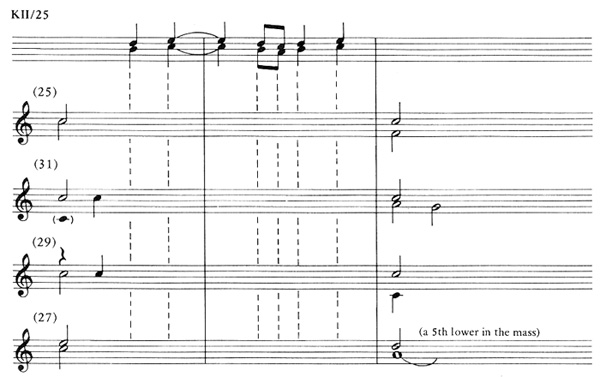
The four variants shown differ only at their points of articulation, but as we shall see they become the subject of further development in later movements.
Parallel structures in the text often receive some kind of parallel musical phraseology.31 The same often holds true of nonliturgical repetitions of text units of various sizes. These structures may take the form of loosely parallel antecedent-consequent phrases," each with its own choral orchestration.32 Long stretches of the Gloria and Credo owe their natural, song-like quality to this pairing of similar units having different terminations. This is roughly equivalent to treating a melodic motive as if its first few notes were the core of its identity. In an appropriate context, that core may consist of surprisingly few notes, as one may see by reexamining Table 3, where only two notes of the comes remain invariant in all eight entries. On the other hand, Palestrina may sometimes have regarded the ends of some motives as their identifying feature. Table 6 shows seven different approaches to the same standard tenor cadence.33
Table 6
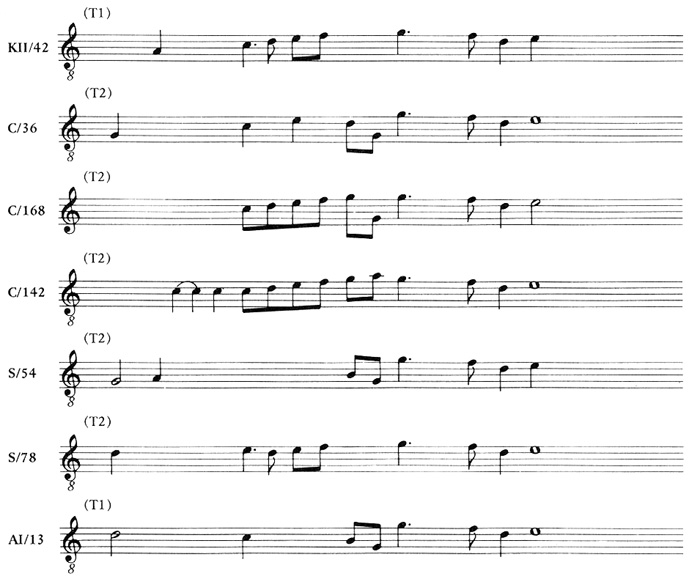
A coherent melodic system need not be based on a common, invariant core. It may consist of a chain of phrases in which small progressive modifications slowly transform the original idea into something quite different. The recognizability of such a relationship will obviously depend on how closely the links of that chain follow one another without significant interruption. Before turning to a more florid example, let us trace the progress of a fairly simple one outlined in Table 7, the chordally harmonized five-note descending scale of C/98.
Table 7
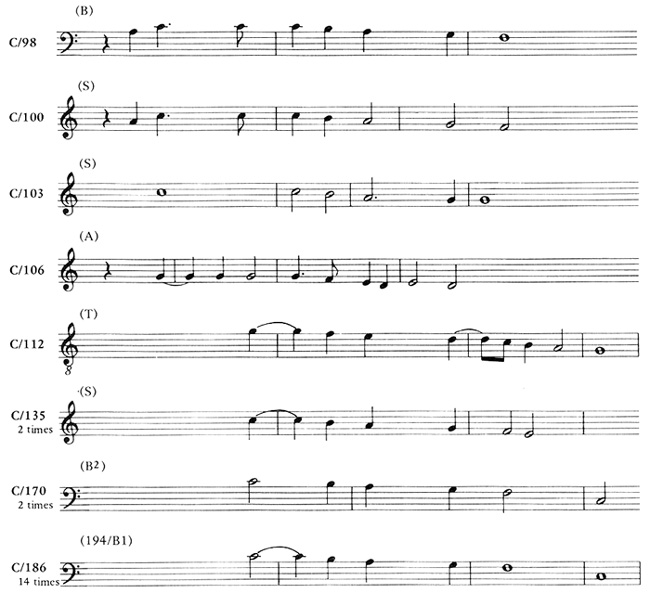
Were it not for its continuous line development, the commonplace material of these closing measures of the Crucifixus would have almost no claim on our attention. However, only one brief interruption occurs (measures 110-112) but fails to disrupt the unity from C/98 through C/115. With that identity thus firmly established, the later recurrences at C/135 and C/170—each emphasized by repetition—retain their recognizability and connect the original chordal idea with its fourteen-fold culmination in the imitative Amen (C/186).
Actually the C/98 group is not new; it represents a subdivision and continuation of a family first introduced at C/11 (see Table 8).
Table 8
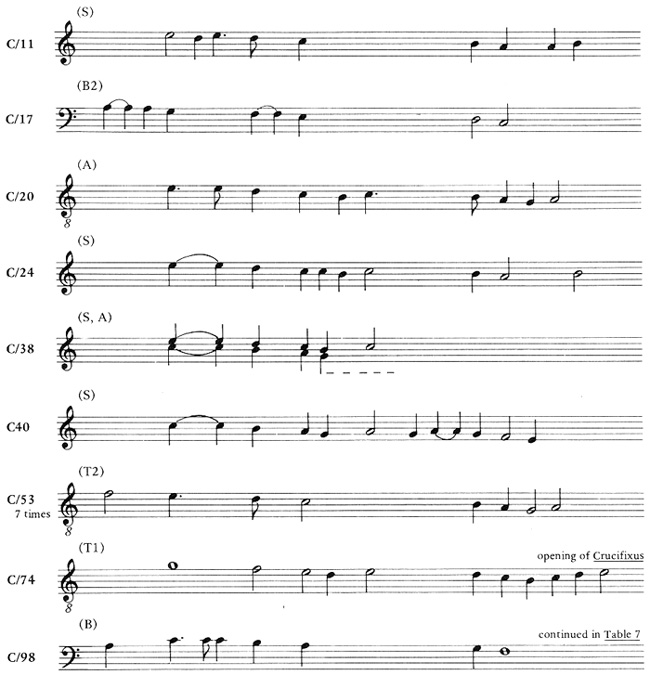
This subject pursued its own course of development to arrive at a natural fulfillment in the conventional word painting of descendit de coelis, with which the movement arrives at its first major structural articulation. As with the family KII/32 that closed the Christe, the simple conjunct downward motion that identifies the whole C/11 family seems at first too commonplace to deserve thematic recognition, but its persistent recurrence (35 times in the course of the movement), its coherent line development, and its prominent placement at the conclusions of three of the four large sections into which Palestrina divides this Credo, point clearly to structural function and to thematic significance.
Interlocking with C/11, another family begins at C/8, pursues its own intermittent development through C/44, and awakens distant echoes later in the movement (see Table 9).34 Together, these two families involve over 90 measures of the movement—nearly half its total length—in their thematic processes.
Table 9
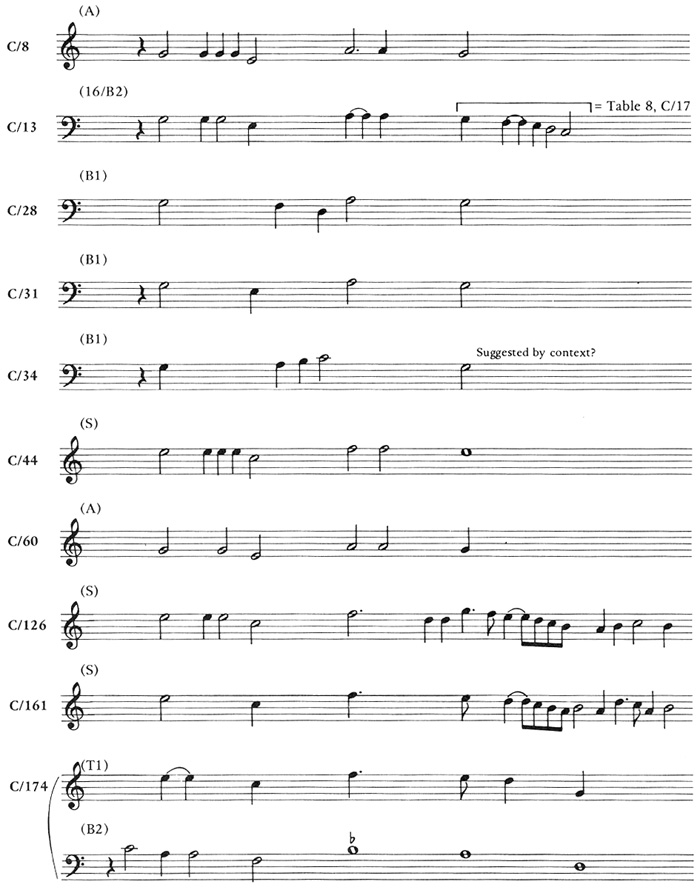
A somewhat more flexible kind of line development unites the last 28 measures of the Gloria (see Table 10).
Table 10
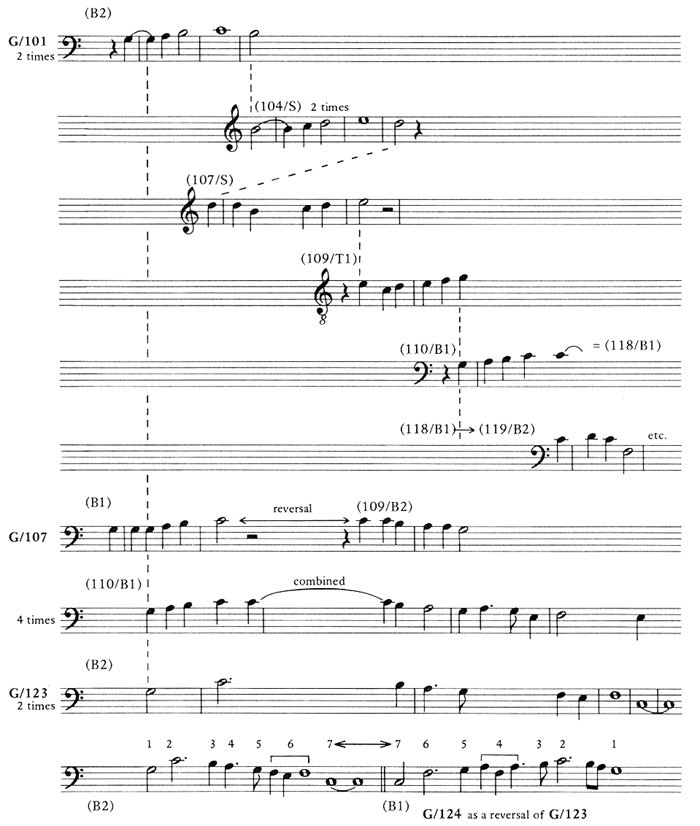
Here, as elsewhere, voice exchange adds to the variety of the choral orchestration. The line that begins at G/101 leaps from voice to voice with relatively little change. There is nothing inevitable about the first few steps traced in Table 10. Other interpretations might have led us through the score by different pathways; but most of them lead to palindromic phrases like that beginning at measure 110 of the first bass. This idea finally emerges at G/123 transformed into a member of the family KI/1 which opened the Mass—and competes here with its own reversal. Is it merely a coincidence that so many strands of the Mass connect to the KI/1 family?
Other motives, too, contribute to the unity of the Mass. The parallel texture that opened the Christe (KII/25) returns another 15 times in constantly changing forms in subsequent movements (see Table 11). Those alterations cannot disguise the melodic, rhythmic, and textural elements that allow them to be heard as a family.
Table 11
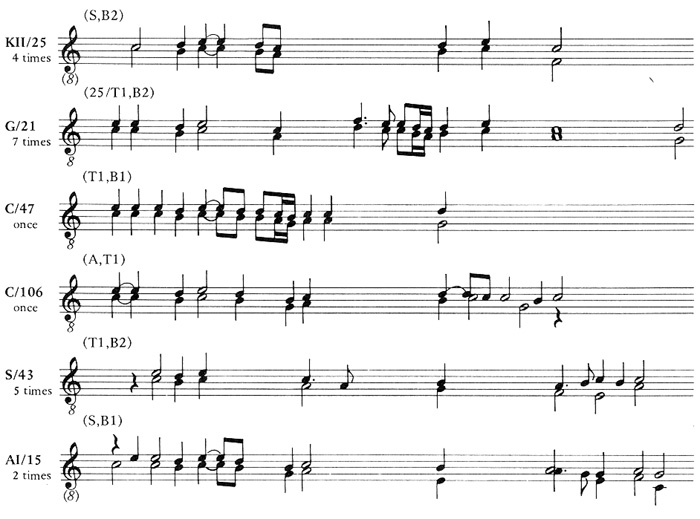
A more subtle but no less effective linkage of movements appears in Table 12.
Table 12
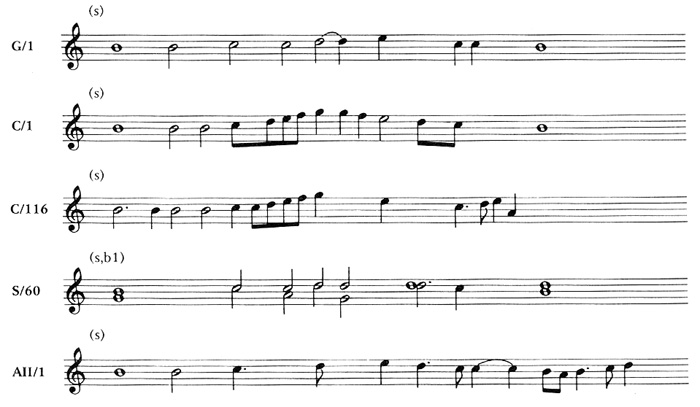
The opening soprano melody of the Gloria does not possess an especially remarkable shape, yet its stepwise ascent from b1 marks five key points of the Mass that have the same character: they are all beginnings, but not fresh beginnings. The Gloria and Credo begin their polyphony after their intonations in plainchant; the reanimated final section of the Credo must make a new beginning after the subdued et incarnatus est and crucifixus; the Hosanna must make a new start after both the Sanctus and Benedictus; finally, Agnus Dei II must also make a new beginning after the cadence of Agnus Dei I. This leaves the Kyrie as the only movement of the Mass not articulated in this fashion.
The Sanctus is particularly rich in connections to other movements (see Table 13).
Table 13
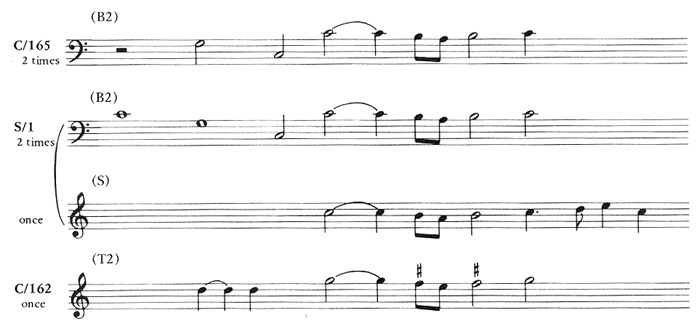
The soprano begins with one of the most commonplace cadential suspensions of the sixteenth century. Its unexpected placement at the opening of a movement and its imitation by both bass parts make it evident that here the cliché attains thematic status. While it would not surprise us to find this ordinary cadence elsewhere in the Mass, it occurs only rarely in the on-the-beat version it assumes in the Sanctus. It does not appear in the conclusion of any of the movements or major sections of movements—as if Palestrina were trying to tell us that he can do without it. Indeed, a wonderful variety of cadences characterizes the whole work. The motive occurs only three other times, clumped together in the Credo almost as they were in the Sanctus. Only the first does it appear as a standard cadence (Credo, measures 166ff., T2); and it persists thematically in the very next phrase where both bass parts deliver it at the pitch level it will use in the Sanctus.
Table 14, which charts themes of the Sanctus, and their relatives in two other movements, requires no explanation except to point out that the opening of the Gloria (G/1) provides an instance in which two parts (here, bass and soprano) share motivic interest (compare Table 12).
Table 14
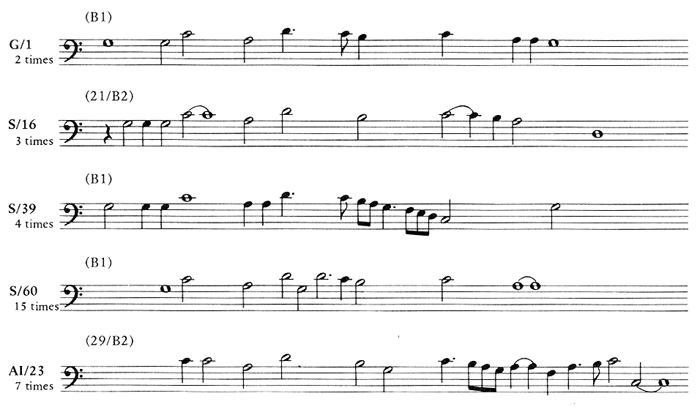
Table 15 records the close connection between the Kyrie and Sanctus.
Table 15
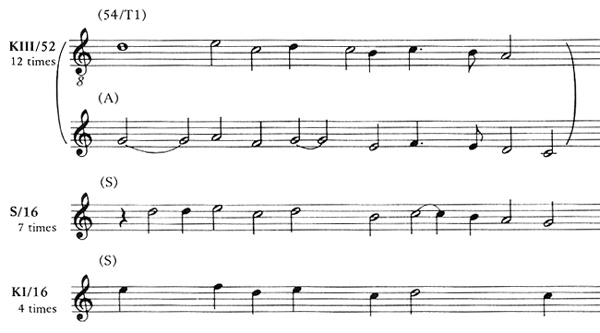
Table 16 compares five triadic melodies which have similar terminations, and adds three more which may perhaps belong to the same family.
Table 16
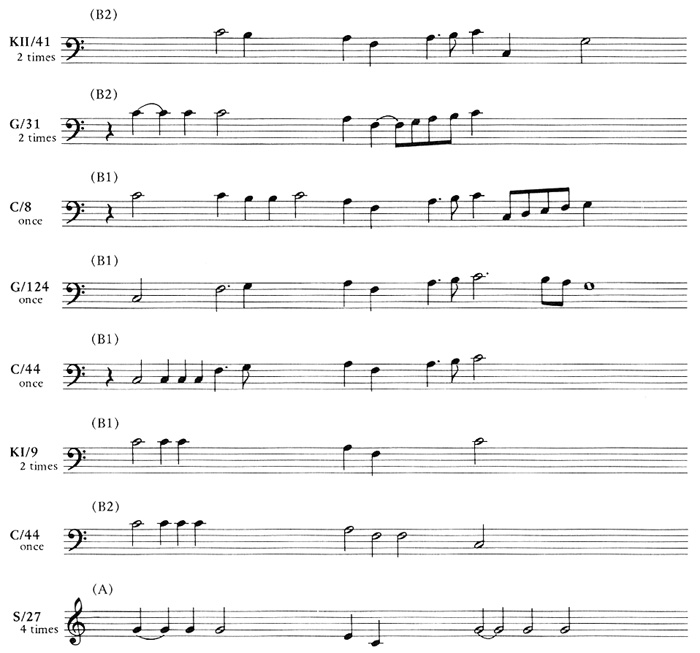
Table 17 suggests the possibility of another retrograde relationship—a possibility somewhat diminished by relationship between C/121 and the versions of C/1 heard in other voices of the passage, beginning at measure 116 (compare Table 12).
Table 17
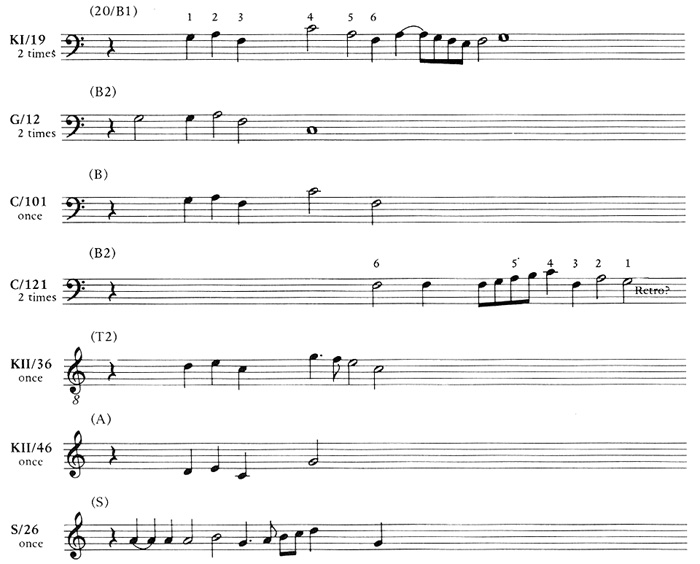
Table 18 shows the diffusion of a small, seemingly unimportant detail which seems to be related to the curious polyphonic repetition in the Credo of a passage from the Gloria (only two voices shown). The chief difference between the passages resides in the octave displacement of soprano and tenor.
Table 18
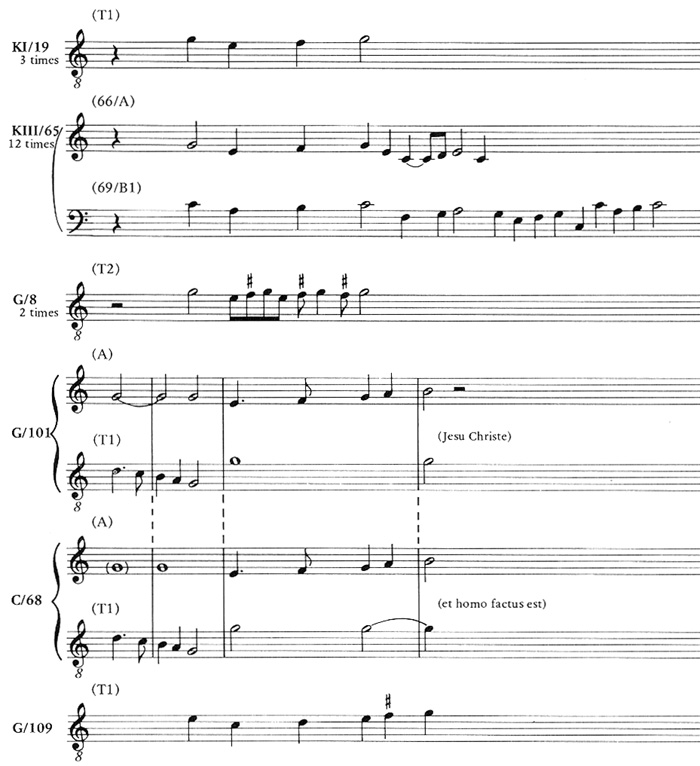
The terms "cliché," "ordinary," and "commonplace" which have so often colored the description of the motives under discussion, might well apply to other melodies in the tables. For example, the zigzag outlines of motives like KIII/52 (equals KI/16, see Table 15) and G/1-bass (see Table 14) do not belong exclusively to Palestrina; in fact the first named family might just as well include a phrase used prominently by Josquin in his Ave Maria (major).35 Although a family like KII/41 (see Table 16) elaborates its basically triadic substance with great variety, it includes members that do not seem to be particularly distinctive. The basic substance of Table 10, notwithstanding the expressive power it generates in the context of the Gloria, has no distinctive character at all. Some motives seem like nothing more than conventional passaggi or divisions; indeed, the main substance of Table 9 appears at the beginning of the first example of simple divisions offered by Ganassi in the Fontegara.36 As for melodies which might at first seem less ubiquitous, Jeppesen has already pointed to the conclusion that Palestrina often used his own materials as if they were common building blocks.37
Of course, it is too early to speculate about the nature of the melodic subjects favored for freely composed Masses and motets, but it does seem as if, in this Mass at least, the composer pursued a deliberate policy of stylistic neutrality with respect to his choice of materials. It cannot be argued that these neutral-sounding materials were intended to serve merely as connections between other, more interesting subjects. These other subjects are often more neutral than the motives under discussion; and the prominent placement, wide dispersal, and frequent occurrence of members of families like KI/1, KII/25, KIII/52, G/1-soprano and G/1-bass suggest rather different conclusions. If the subjects to which Palestrina granted structural significance are essentially commonplace, they are also basically quite flexible. And because, as Morley said (above), the composer is tied to nothing, he may show all the more art by calling freely on the techniques at his command to raise the commonplace to a new musical beauty and expressive power.38
We still have much to learn about the art that accomplishes such ends, but surely the observations collected here must form a part of it. The material quoted in our tables represents more than one-quarter of the total number of measures of the individual voice parts of the Mass (after due allowance for measures of rest).39 Thus if one accepts the interpretations of the tables, we must recognize, even by the crude insights that such raw numbers afford, that some kind of unifying melodic activity permeates a very substantial portion of the Mass.
The type of motivic relationships summarized in our tables may at first seem more apparent to the singers of the individual parts than to most listeners—and it is true that this study stems from a period of intensive rehearsal of the missa with a small ensemble.40 Yet this cannot diminish the significance of the observations. Perhaps we shall have to consider reshaping our styles of performance and interpretation to communicate more effectively the unity of the melodic element.
What is the nature of the unity suggested here? Not that of Classic-Romantic music with its specialized thematic functions,41 yet it has more than a little in common with Schumann's Carnaval and its persistent reworking of a small group of notes. It lacks the formal thematic ordering of eighteenth- and nineteenth-century music because in sixteenth-century music that kind of order resides in the text—which must take priority over even a cantus prius factus. Have we been assaying fool's gold, melodic parallels which emerge only when we examine their contours from too close a perspective? Possibly one has to step back from Renaissance melody and consider it in the larger dimension. It may well prove that many of the resemblances we have called thematic (for want of a better term) are really no more than details of lower levels of the thematic process. Even so, the persistence of such details must reveal something about the economy and coherence of the language of the Mass; if not about its overall organization, then surely about the vocabulary in which those larger dimension thematic structures are couched. The unity of this deeper level illuminates those qualities of poise and propriety which set the Missa Papae Marcelli apart even in the œuvre of a Palestrina.
1Occasionally identified below as MPM. It will also prove convenient to refer to the cantus voice part as the soprano, making the symbols for the voices: S (1 and 2 in Agnus II), A, T1, T2, B1 and B2. The discussion in this study will refer to the edition of the Mass edited by Raffaelle Casimiri in Opere complete di Giovanni Pierluigi da Palestrina, Vol. IV (Rome, 1939), pp. 167-201, particularly as reprinted in the series of Norton Critical Scores: Giovanni Pierluigi Palestrina: Pope Marcellus Mass; An Authoritative Score. . . , edited by Lewis Lockwood (New York, 1975). It will prove convenient to refer to this latter edition, which includes much valuable material, as NCS. Lockwood has corrected some typographical errors of the Casimiri edition; to his list (NCS, p. 78) we may add a few more that have surfaced: NCS, p. 45, measure 47, B1, and p. 47, measure 87, A: delete second tie (presumably intended to record ligatures); p. 50, measure 22, B2: add quarter rest. In addition, three notes are almost unquestionably incorrect: the first note of the soprano in the Gloria, given as d2 in NCS, p. 43, measure 1, should read b1 as in Casimiri—a difference of some analytical significance which is confirmed by Anerio, Soriano, and a Milan Anonymous (see below in this note). In Agnus Dei I, (NCS, p. 68), a stylistically incompatible dissonance—unconfirmed by the sources—sources named—mars the soprano's conventional cadence with a most unconventional b in B1, measure 49; the note should surely be read as a d1 to conform with regular cadential practice. Finally, in Kyrie II, measure 63 (NCS, p. 42) the soprano looks suspiciously static in the context of the prevailing point of imitation; the second e2 should almost certainly be corrected to c2—a reading confirmed by Soriano (see below). Casimiri's underlay is often open to disagreement, but at least one significant oversight should be noted here: in Kyrie I (NCS, p. 40), measure 16, B1 imitates B2 and should also, therefore, begin a new phrase; both parts would best carry the word "Kyrie" on the first four notes of the point (two notes for the syllable "Ky-"). Casimiri's publishers—not Professor Lockwood—must bear the responsibility for some of the deficiencies in NCS. They corrected errors of the first edition in a second one which lacks the usual notice of change. Lockwood worked with the corrected edition, while his publishers—in all good faith—made plates from the earlier one. Inevitably, the prior publisher's indifference to bibliographical accountability comes to light in the harm it does elsewhere. Lockwood cites Jeppesen's list of some of the secondary sources of the Mass (NCS, p. 77); to this it is desirable to add, because of the valuable clues they provide, the four- and eight-part arrangements of the Mass by Anerio (1622) and Soriano (1609) respectively, both of whom were pupils and colleagues of Palestrina. Their Masses have been reprinted by Hermann J. Busch, Giovanni Francesco Anerio and Francesco Soriano: Two Settings of Palestrina's Missa Papae Marcelli, Recent Researches in the Music of the Baroque Era, Vol. XVI (Madison, 1973). Busch reports that eight such arrangements are accessible (Busch, note 14), the earliest being an anonymous four-part arrangement (Milan, 1590), reprinted by F.X. Haberl in Erster Nachtrag zur Gesamtausgabe der Werke von Pierluigi da Palestrina (Leipzig, n.d.)—as volume XXX of his Pierluigi da Palestrinas Werke—pp. 15-27.
2Its fame does not depend on the now generally disregarded legend that it "saved" church music (see NCS, pp. 28 ff.). Only its musical appeal can have motivated its six or seven sixteenth-century reprints and the eight arrangements mentioned in note 1, above.
3I distinguish here between cantus prius factus and cantus firmus, applying the former to preexistent material used in any fashion (paraphrase, parody) and restricting the latter to the structural voice (usually an inner voice) that contributes to the organization of a piece, but not (usually) to its foreground.
4Irving Godt, "Renaissance Paraphrase Technique: A Descriptive Tool," Music Theory Spectrum II (1980), 110-118.
5A step in the right direction appears in Quentin W. Quereau's "Sixteenth-Century Parody: An Approach to Analysis," Journal of the American Musicological Society XXXI (1978), 407-441.
6The excellent study by Robert G. Luoma, "Relationships Between Music and Poetry (Cipriano de Rore's Quando signor lasciaste)," Musica disciplina XXXI (1977), 135-154, shows us how valuable such a study can be dealing with just a single madrigal. However, such investigations will never have a secure basis until we can distinguish confidently between the ordinary and the extraordinary. A prerequisite to work in that direction is a set of concordances of all the texts in each repertory; these would allow us to compare the treatments of the same word or idea on a repertory-wide basis. As a beginning, I have compiled a computer-assisted concordance of the texts of English secular music from 1571 to 1632. I hope to find a way to make this tool available to others in the not too remote future.
7Irving Godt, "Motivic Integration in Josquin's Motets," Journal of Music Theory XXI (1977), 264-292.
8Joseph Samson, Palestrina, ou La Poésie de l'exactitude (Geneva, 1940), p. 176. The opinion perpetuated by Karl Gustav Fellerer, "Le messe e i mottetti del Palestrina" (trans. Lorenzo Bianconi), in Lino Bianchi and Karl Gustav Fellerer, Giovanni Pierluigi da Palestrina (Milan, 1971), p. 325. Possibly the first to cite this resemblance was Henry Coates, who also notes other similarities: Palestrina (London, 1938), pp. 111ff.
9Albert Seay, ed., Jacobi Arcadelt Opera Omnia, Vol. II, Corpus mensurabilis musicae, No. XXXI (Rome: American Institute of Musicology. 1970), pp. 39-40.
10Gustave Reese, Music in the Renaissance, revised ed., (New York, 1959), p. 816 et passim.
11Knud Jeppesen, "Problems of the Pope Marcellus Mass: Some Remarks on the Missa Papae Marcelli by Giovanni Pierluigi da Palestrina" (trans. Lewis Lockwood), NCS, pp. 115ff. and 125ff.
12Jeppesen, "Problems," pp. 115-116.
13Cited in Jeppesen, "Problems," p. 110, n. 7.
14Michel Brenet's surmise that one must exist is quoted in Jeppesen, "Problems," pp. 109-110.
15Jan LaRue, "Significant and Coincidental Resemblances between Classical Themes," Journal of the American Musicological Society XIV (1961), 224-234.
16See note 13 above.
17MPM, Gloria, measures 8-12, soprano (NCS, p. 43).
18Liviu Comes, Melodica palestriniana (Bucharest, 1971; Italian translation by P. Derossi and T. Sofonea, Venice, 1974-75), devotes particular attention to that relationship. Ermenegildo Paccagnella, Palestrina: il linguaggio melodico e armonico (Florence, 1957), devotes his first chapter to "Il canto gregoriano fondamento della polifonia palestriniana"; unfortunately, he cites (on pp. 4-5) chants of the Ordinary that I am unable to find in the Kyriale. On the other hand, Robert L. Marshall demonstrates that for Palestrina even plainchant hymns might require some simplification; "The Paraphrase Technique of Palestrina in His Masses Based on Hymns," Journal of the American Musicological Society XVI (1963), 359-60.
19LaRue, "Significant," pp. 235-36.
20For at least one private performance associated with Tridentine deliberations on music, see NCS, pp. 21-22. For references to the singing of motets in nonliturgical and even nonreligious applications, see Anthony M. Cummings, "Toward an Interpretation of the Sixteenth-Century Motet," Journal of the American Musicological Society XXXIV (1981), 43- 59.
21Thomas Morley, A Plain and Easy Introduction to Practical Music, edited by Alec Harman, 2nd ed., (New York, 1963), p. 296; see also Morley's remarks on overworking a point, pp.270-71.
22Morley, pp. 292ff.
23This remark does not address the opposition of contrasting countersubjects.
24Siegfried Hermelink prefers to regard the first entry as merely introductory: Dispositiones modorum (Tutzing, 1960), p. 127.
25The parenthesized first note of 5/t1, d1, is also the last note of the preceding phrase, 1/t1. Most editors take that note as the beginning of the second phrase, alloting it as the first syllable of Kyrie. The underlay in our table implies that the phrases form an antecedent-consequent pair. The dotted lines enclose six common cadential pitches. Our reading agrees with the three arrangements cited in note 1, above, all of which end their first phrases on the more natural-sounding d1. Even this "worst case" fails to weaken the equivalence between 5/t1 and the other members of the group.
26Godt, "Motivic," p. 267.
27Obviously, one can easily form a conflicting example. Consider the series of phrases containing two stylistic elements: ab, bc, cd. While ab and cd are both related to bc, they have nothing directly in common with each other.
28Reese (Renaissance, p. 480) not only recognized many of the relationships in Table 1, but perceived more distant relationships between some of our families with respect to this opening theme; for example, with the beginning of the Hosanna which appears in our Table 14 as a member of the family G/1-bass. That relationship falls outside the scope of this study.
29Among others, Lockwood in his introduction to NCS, p. viii, and Jeppesen, "Problems," NCS, p. 117 (notwithstanding p. 129).
30The reappearance of such motives had much in common with Palestrina's return to new versions of his cantus prius factus, noted by Marshall, "Paraphrase," pp. 362-63, and the technique of motivic development Marshall cites, pp. 364-65.
31As pointed out by Lockwood, "Notes on the Text and Structure of the Pope Marcellus Mass," in NC, pp. 87ff.
32See for example the repetitions of Domine Deus Agnus Dei in the Gloria, measures 45ff. and 49ff. (NCS, p. 45). On this point see note 38 below, and also Knud Jeppesen, The Style of Palestrina and the Dissonance, 2nd revised ed., with minor corrections (New York, 1970), p. 46. See also Lockwood, "Notes," NCS, pp. 88-89.
33Jeppesen, Style, pp. 70ff., and 209ff., discusses this ubiquitous Palestrina figure in detail.
34The phrase C/34 has little in common with the other motives of Table 9 except for its end-points and its metrical outline. Its position in this continuous development, its proximity to C/28 and C/31 suggest that it has some degree of functional equivalence to them. The whole passage from measure 28 to measure 38 is especially vigorous and exciting. It contrasts strikingly with Dalia Cohen's title characterization, "Palestrina Counterpoint: A Musical Expression of Unexcited Speech," Journal of Music Theory XV (1971), 84-111; and Malcolm Boyd's ill-chosen "passionless" Palestrina's Style: A Practical Introduction (London, 1973), p. 11. Surely it is time to reconsider such language.
35In Werken van Josquin des Prez, afl. 1, edited by Albert Smijers (Amsterdam, 1923), p. 2, measures 64ff., ("Ut lucifer lux oriens"). Josquin was especially fond of such chains of thirds; see the discussion of his Benedicite omnia opera Domini Domino in Godt, "Motivic," pp. 265-72; and of the Ave Maria, pp. 274-81.
36Sylvestro Ganassi, Opera intitulata Fontegara (Venice, 1535), edited by Hildemarie Peter, English translation by Dorothy Swainson (Berlin-Lichterfelde, 1959), p. 16. Adrian Petit Coclico, in his Compendium musices (Nuremberg, 1552), tells us that Josquin saw to it that his pupils learned to embellish melodies ("ornatem canere"; folio Fii verso); see the translation in Reese, Renaissance, p. 230. The study of division and embellishment seems to have been regarded as preliminary to more advanced work in composition—in which the pupil would have to learn to "wrest" his point.
37See note 12 above. We may add a few additional examples of such reuse. KI/19 appears briefly in the Kyrie of Palestrina's Missa de Beata Virgine; Opere, Vol. IV, p. 2, measure 22, bassus. The opening of his motet O admirabile commercium is a fraternal twin of the opening of our Sanctus; Opere, Vol. V, p. 1. Parallels between the tenor parts of our Laudamus te, benedicimus te (Gloria, measures 8-12) occur on the same words, but with ornamental differences, in his Missa ad fugam, Opere, Vol. IV, p. 75, measures 6-10.
38One of the techniques he uses is choral orchestration. Of the 42 combinations of three or more voices possible in a six-part ensemble, Palestrina makes use of 35. In addition to these he introduces three different duets in the four-part sections, and 19 other combinations in the seven-part Agnus Dei. In the Gloria and Credo the full six-voice texture sounds less than one-fifth of the time, and it is contrasted with some 25 different choral combinations. For additional discussion see Lockwood, "Notes," NCS, pp. 88ff.
39Total number of voice-part measures: 3,663, less 516 measures of rest equals 3,147 "singing measures"; our tables total 888 measures after deducting duplications, or well over one-fourth.
40The Pittsburgh Madrigal Singers, to whom I here express my warm thanks.
41On thematic specialization see Jan LaRue, Guidelines for Style Analysis (New York, 1970), pp. 119-20.


